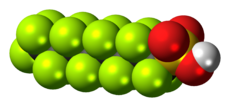
Back حمض بيرفلوروأوكتان السلفونيك Arabic پرفلوئورواوکتانسولفونیک اسید AZB Àcid perfluorooctanosulfònic Catalan PFOS Czech Perfluoroctansulfonsäure German Azido perfluorooktanosulfoniko Basque پرفلوئورواکتانسولفونیک اسید Persian Acide perfluorooctanesulfonique French Acido perfluoroottansolfonico Italian ペルフルオロオクタンスルホン酸 Japanese
 | |
 | |
| Names | |
|---|---|
| Preferred IUPAC name
1,1,2,2,3,3,4,4,5,5,6,6,7,7,8,8,8-Heptadecafluorooctane-1-sulfonic acid | |
| Other names
PFOS
| |
| Identifiers | |
3D model (JSmol)
|
|
| ChEBI | |
| ChemSpider | |
| ECHA InfoCard | 100.015.618 |
| EC Number |
|
| KEGG | |
PubChem CID
|
|
| UNII | |
CompTox Dashboard (EPA)
|
|
| |
| |
| Properties | |
| C8HF17O3S | |
| Molar mass | 500.13 g/mol |
| Boiling point | 133 °C (271 °F; 406 K) at 6 torr |
| Acidity (pKa) | <<0[1][2] |
| Hazards | |
| Occupational safety and health (OHS/OSH): | |
Main hazards
|
Toxic, persistent environmental pollutant |
| GHS labelling: | |
  
| |
| Danger | |
| NFPA 704 (fire diamond) | |
| Pharmacology | |
| Legal status |
|
| Related compounds | |
Related compounds
|
Perfluorooctanoic acid (PFOA), Perfluorobutanesulfonic acid (PFBS), Perfluorooctanesulfonamide (PFOSA), Perfluorononanoic acid (PFNA) |
Except where otherwise noted, data are given for materials in their standard state (at 25 °C [77 °F], 100 kPa).
| |
Perfluorooctanesulfonic acid (PFOS) (conjugate base perfluorooctanesulfonate) is a chemical compound having an eight-carbon fluorocarbon chain and a sulfonic acid functional group, and thus it is a perfluorosulfonic acid and a perfluoroalkyl substance (PFAS). It is an anthropogenic (man-made) fluorosurfactant, now regarded as a global pollutant. PFOS was the key ingredient in Scotchgard, a fabric protector made by 3M, and related stain repellents. The acronym "PFOS" refers to the parent sulfonic acid and to various salts of perfluorooctanesulfonate. These are all colorless or white, water-soluble solids. Although of low acute toxicity, PFOS has attracted much attention for its pervasiveness and environmental impact. It was added to Annex B of the Stockholm Convention on Persistent Organic Pollutants in May 2009.[4]
- ^ Cheng J, Psillakis E, Hoffmann MR, Colussi AJ (July 2009). "Acid dissociation versus molecular association of perfluoroalkyl oxoacids: Environmental implications" (PDF). J. Phys. Chem. A. 113 (29): 8152–8156. Bibcode:2009JPCA..113.8152C. doi:10.1021/jp9051352. PMID 19569653.
- ^ Rayne S, Forest K, Friesen KJ (2009). "Extending the semi-empirical PM6 method for carbon oxyacid pKa prediction to sulfonic acids: Application towards congener-specific estimates for the environmentally and toxicologically relevant C1 through C8 perfluoroalkyl derivatives". Nature Precedings: 1. doi:10.1038/npre.2009.3011. hdl:10101/npre.2009.2922.1.
- ^ An Act To Stop Perfluoroalkyl and Polyfluoroalkyl Substances Pollution. 130th Maine Legislature, April 15, 2021
- ^ Governments unite to step-up reduction on global DDT reliance and add nine new chemicals under international treaty. Geneva: Stockholm Convention Secretariat. 8 May 2009.
